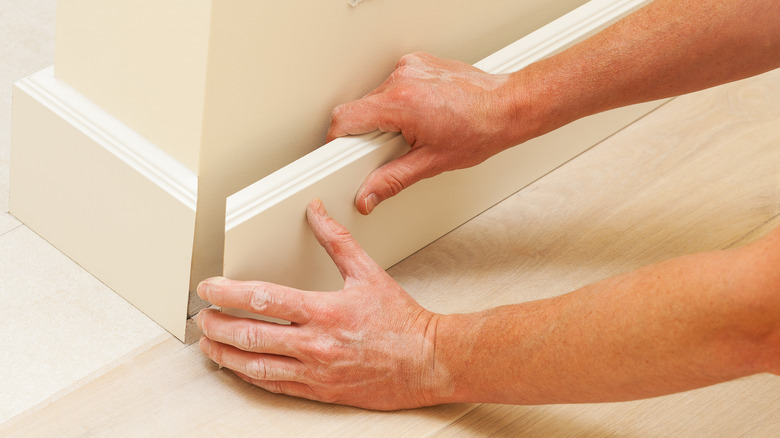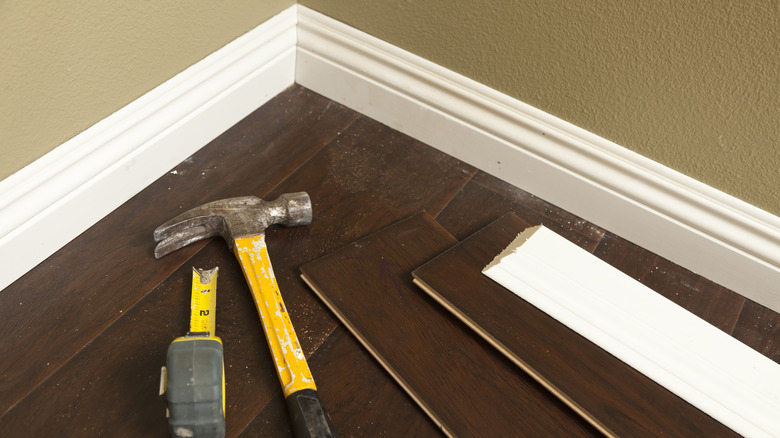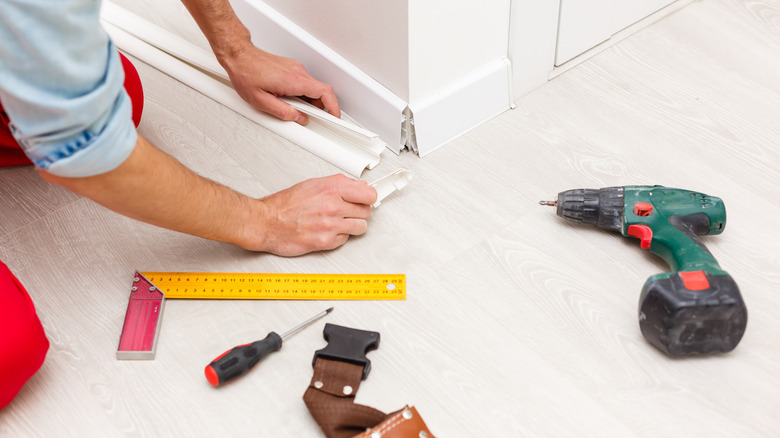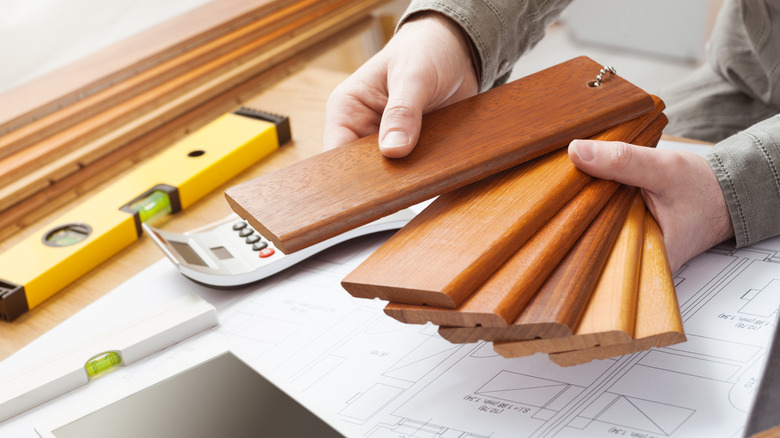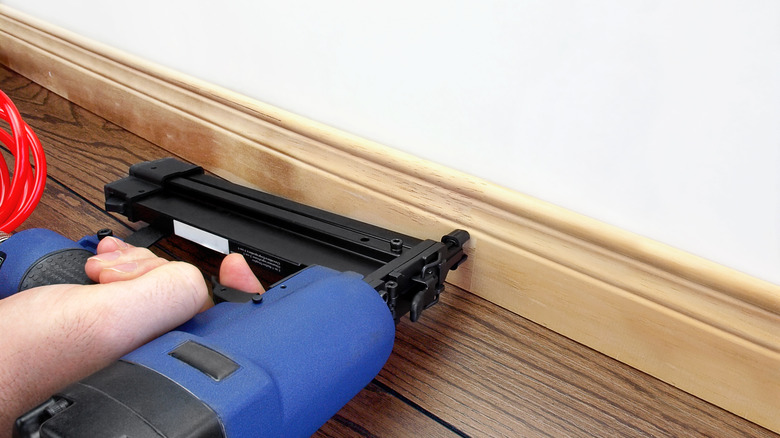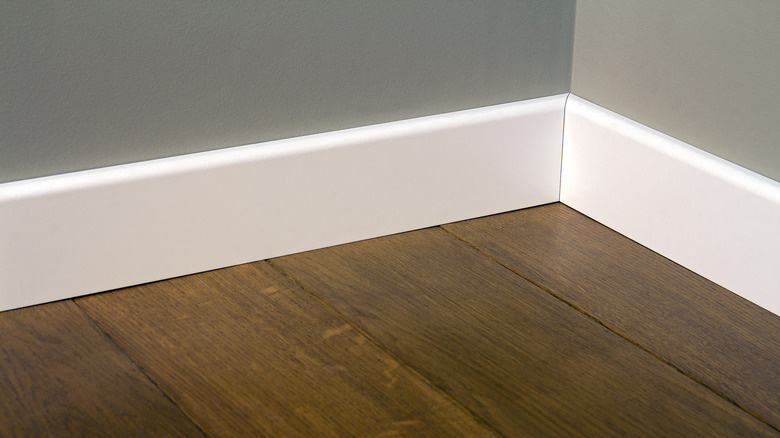How Much Does It Cost To Install A Baseboard?
A baseboard is an important finish in any home that cannot be overlooked. In fact, they are quite visible and you will immediately notice if a room lacks this finish. However, the baseboard's primary function in the house is more than just for aesthetics. Baseboards seal the space between the floor and the wall, especially with hardwood flooring. In addition, a baseboard can also help to hold laminate flooring firmly in place since nails are not used during the installation. Other than these functional benefits, baseboards play an important role in adding the finishing details and provide a clear distinction between the floor and the wall.
So how much does it cost to install baseboards? According to HomeAdvisor, the cost per linear foot ranges from $5.70 to $8.95. However, your overall quote might be higher depending on the unique circumstances of your individual project. HomeAdvisor further notes that the cost of installing baseboards throughout smaller homes averages at $720 but could increase to $1300 for larger homes.
Factors for cost
When it comes to baseboard installation, every home has its own set of factors that should be considered when establishing an estimate. Here is a breakdown of some of those factors according to Home Improvement Cents.
Baseboard materials
There are plenty of options when it comes to baseboard materials, and your budget and preference will determine what materials to go for. It goes without saying that basic baseboard materials like PVC are cheaper than top-of-the-range options like maple or mahogany. In addition, some baseboard materials are more complicated to install and may require more time to install, leading to a higher cost as far as labor per hour is concerned.
The scope of the project
It is unsurprising that bigger projects ultimately cost more than smaller ones. For baseboard installation projects, you can easily estimate the average size of your project by crunching a few numbers. You need to take the measurements of the walls that need installation and subtract the width of the doorways. Request a quote per linear foot from several different contractors, then multiply this with your project size to come up with an estimate. It is good practice to request several quotes to compare the costs of different contractors. It is worth mentioning that some contractors offer discounts per linear foot for larger projects.
Labor
On average installation costs around $5 to $7 per foot. However, the cost of labor changes from one region to another, therefore, how much you will have to pay is strictly dependent on the rates of your region. You can expect the labor cost in areas with a relatively higher cost of living to be more expensive. On the other hand, regions with a lower standard of living have equally lower labor costs for the installation of baseboards.
Painting
Baseboards that come unpainted are often referred to as bare and will need a coat of paint to make them look appealing and match the décor of your home. If you are considering repainting your entire house, it may be a good idea to leave the painting job to a decorator. Nonetheless, talk to your carpenter to find out whether they offer baseboard painting services. On average most baseboard installers charge an extra $1 to $5.70 per linear foot for painting services.
Additional costs
Other than the basic installation cost factors mentioned above, you should also factor in the additional costs that will definitely come up along the way.
Removing the old baseboard
This is particularly true for baseboard replacement, the installer will need to remove the old baseboard to create room for the installation of a new one. The space may need additional preparation for a new installation by sanding down any existing paint and leftover glue. Angi notes that site preparation and removal of old baseboard costs between $50 to $100 for every hour.
Debris removal and disposal
Once the replacement is complete, you will need to have the area cleaned and the old baseboard removed. If the cost of cleaning and disposal is included in the overall quote your installer should take care of the clean-up duties, otherwise, you will need to hire a separate disposal team that will cost you approximately $17 to $23, explains Home Improvement Cents.
Other repairs
It is common practice for homeowners to also include other baseboard-related repairs to ensure a uniform aesthetic that matches the new finish. Any additional repairs will likely involve extra costs depending on the specific repair and the extent of damage that needs fixing. Angi, reports that one of the most popular jobs that baseboard installers work on is the repair of the drywall, which can cost between $280 to $790.
Types of baseboards
There are plenty of baseboard styles available and each one has its own unique benefits. Here are some of the popular types of baseboard materials you can choose from, via HomeGuides.
Vinyl baseboards
Vinyl is a synthetic material that is popular because of its flexible nature. Baseboards made out of vinyl are waterproof, sturdy, and pliable enough to bend around awkward angles. They are a good choice for areas with more humidity or frequent water splashes such as bathrooms and kitchens. Vinyl is not only easy to cut but it is also easy to paint, however, you should be aware that vinyl baseboards are not as visually attractive as other types of baseboards, like hardwood.
Composite baseboards
Often referred to as MDF (medium-density fiberboard), this synthetic material is relatively affordable compared to solid wood, and is more pliable. MDF is available in long lengths making it a good option for long stretches of wall. Most options are available in several profiles and are already primed. However, the major downside is that the composite material is not quite as tolerant to moisture as its vinyl counterpart.
Hardwood baseboards
This is a popular choice for homeowners who desire a luxurious finish in their homes. There are plenty of hardwood options including maple, pine, or oak. Hardwood baseboards are usually produced in standard 96-inch lengths which can be cut down to size depending on your installation requirements. In contrast with the other mentioned types, hardwood baseboards are the most durable. Consequently, they are also the most expensive, but most homeowners choose to look at the cost as a long-term investment.
Why you need a baseboard
Installing new baseboards is one of those inexpensive home improvement projects that arent strictly necessary, in fact, not every home has a baseboard installed. So why should you consider installing them in your home? Let's take a look at a few reasons offered by Don Pedro Home Design.
To improve the home value
The aesthetic appeal of a home is determined by many things, including the type and quality of the interior finishes. A home with a good curb appeal is likely to fetch a better price when it comes to property valuation. So if you are considering putting your home up for sale in the near future, installing new baseboards is a simple yet cost-effective way of increasing the value of your house.
Adds character and personality
Baseboard styles that can be repainted give you the opportunity to customize your home however you want. You can paint the baseboard to match the color palette of the room or go for a completely different color choice that fits your personality. There are no rules when it comes to paint colors, or customizing your home according to your preference.
Benefits of installing a baseboard
While baseboards are known for their aesthetic value, there are plenty of other benefits that come with the installation. Here are a few examples from Home Improvement Cents.
Protects your wall
The bottom part of your wall is particularly vulnerable to damage from many different agents including, vacuum cleaners, outdoor footwear, or kids playing around in the house. Baseboards protect the walls in your house from physical damage, thus saving you from frequent maintenance.
Protection against water damage
This is particularly true for vinyl baseboards, which are waterproof and seal the space between the floor and the wall tightly. Drywall materials should not be in contact with water and one way of ensuring they don't is to install baseboards with a high moisture tolerance. Once the drywall absorbs moisture it quickly swells up and loses its durability.
Easy cleaning
The gap between the wall and the floor is a common location for dirt and debris to collect. This poses a challenge when you need to clean between these spaces. If you have ever tried removing dirt from tiny cracks and crevices, you will understand how frustrating it can be. Installing a baseboard conceals this gap and makes it easy to clean the areas near the wall.
